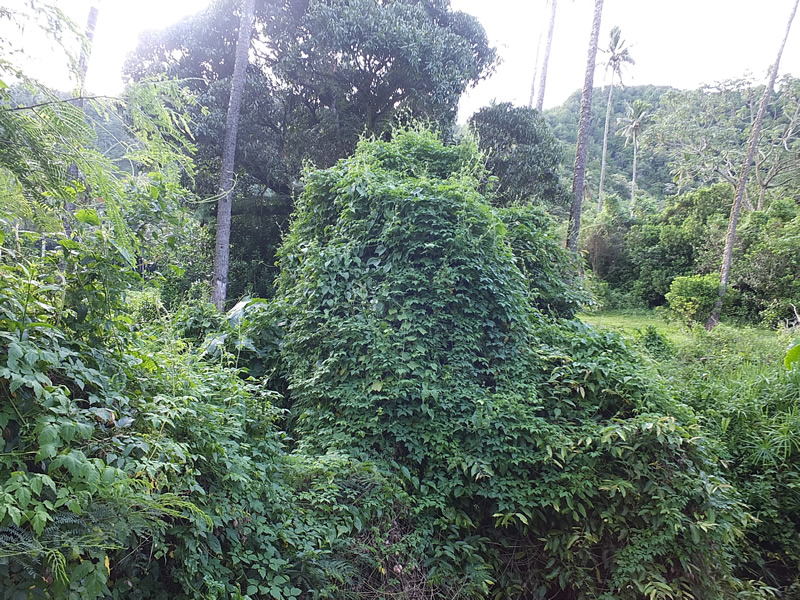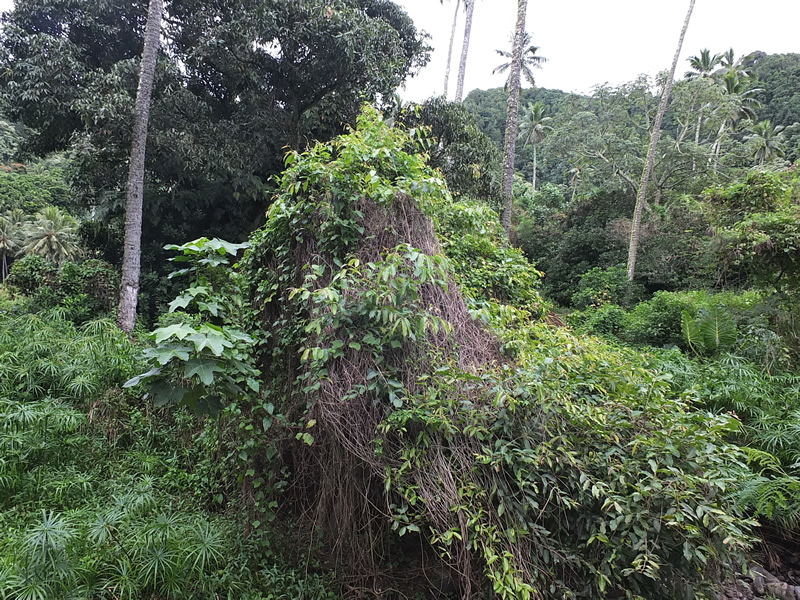Great results in the Cook Islands
The technical advisory group for the Cooks Islands Biocontrol Project met in Rarotonga in June, which gave Quentin Paynter an opportunity to visit and assess the performance of the agents recently released there to combat a variety of invasive weeds. He was excited by some of the results visible already.
In December 2017 a rust fungus (Puccinia archavaletae) was released in an attempt to bring down grand balloon vine (Cardiospermum grandiflorum). This plant is rampant there, but the rust has quickly done spectacularly well. Analysis of 20 photo points set up at release time indicated that by June 2018 grand balloon vinepercentage cover had declined by 90%. Both native and exotic plants have benefited from balloon vinecontrol, although the greatest increase was recorded for another biocontrol target, mile-a-minute (Mikania micrantha).
“Grand balloon vine is often intertwined with this other weedy climber, so the impact isn’t yet that obvious to the casual observer,” said Quentin. However, hopefully this will be short-lived, as another rust (Puccinia spegazzinii),released on mile-a-minute, although slower to get going is starting to spread out from the Avatiu Valley, where it first established, to other locations in the north and west of Rarotonga. At the current rate of spread this rust should be widespread within a couple of years. If the impacts of Mikania rust are similar to those being reported from Vanuatu and elsewhere, there should be comprehensive control of the plant starting to happen in the next couple of years throughout Rarotonga.



“We always knew that removing just one of the weedy vines would not be enough, which is why we tackled the three main invasive vines in Rarotonga,” said Quentin. The third vine targeted is red passionfruit (Passiflora rubra). The red postman butterfly (Heliconius erato cyrbia), released against this plant in 2016, has also already had a noticeable impact. “We found around 60% of the stem tips we examined had been attacked by the larvae of this butterfly, and that in some localities the adults are extremely abundant,” said Quentin.
Fears resulting from early reports of female butterflies laying eggs on edible purple (also known as black) passionfruit (Passiflora edulis) have been allayed after only 1% of leaf tips of purple passionfruit examined had either an egg or early instar larva present on them. “This is likely to be what we call ‘spill-over’ attack, where there are such high numbers of butterflies that they try to lay eggs on nearby plants even if there is little or no chance of the larvae surviving,” Quentin said. “No mature larvae were found on these vines nor any evidence of significant feeding damage, so it is unlikely to be having any effect on the plant or its ability to produce passionfruit,” Quentin added. This is consistent with host range test results, which indicated that the edible passionfruit vines are toxic to the red postman larvae, which die before causing noticeable damage to the plants. Such spill-over damage is expected to decrease as the red passionfruit declines and the butterflies become less numerous.
There have also been good results with the cocklebur rust fungus (Puccinia xanthii),which is now widespread and has previously been observed to be causing reduced vigour of cocklebur (Xanthium strumarium). “We can also confirm that the first agent (Colomerus spathodeae)to be released for the African tulip tree(Spathodea campanulata)is well established. A second agent for this tree, a leaf-mining flea beetle (Paradibolia coerulea),is currently being developed by Iain Paterson from Rhodes University. We hope to submit an application to release this beetle in Rarotonga over the next few weeks,” confirmed Quentin.
The main involvement by Manaaki Whenua – Landcare Research in this 5-year project is due to end later this year, but there will be some ongoing work for local experts to continue with, such as ensuring that all the agents are established widely, including on other islands in the Cooks group. A scale insect(Tectococcus ovatus), released to control strawberry guava (Psidium cattleianum), is currently only established in a very localised area, and given that natural dispersal of this agent will be slow, it will definitely need some help to move it around. Another key task will be to monitor and document the ongoing impact the biocontrol agents have over time. A training workshop is planned for November to ensure a group of local experts can keep the good work going.
“Overall, the latest visit has shown that we are making serious inroads on the vines and trees that were starting to smother Rarotonga. We are thrilled with the results already, and our decision to hit multiple weed targets with a range of host-specific agents appears to have been validated,” concluded Quentin.
As well as the biocontrol component to this project, a study into the appropriateness of targeting an eighth species, peltate morning glory (Decalobanthus peltatus, formerly Merremia peltata), has been completed. There were conflicting views on whether this invasive vine is native or introduced to the Pacific, and a molecular study has been undertaken to resolve this. Samples from across the Pacific have been analysed, and it was concluded that there is evidence that peltate morning glory has been present in the South Pacific for some time, with additional introductions made more recently. This supports previous suggestions that the vine is both native and introduced to the Pacific.
“It seems likely that peltate morning glory has become weedy in recent decades in some places because it thrives on human and other disturbance (including cyclones), although some studies have indicated that global change might be a factor, as elevated atmospheric CO2 levels can favour the growth of woody vines over forest trees,” said Quentin. “Although natural enemies may occur in other parts of peltate morning glory’s native range that could potentially be introduced to reduce its vigour in the Cook Islands, I wouldn’t recommend it at this stage without further studies,” he added, noting that in an agricultural context peltate morning glory can be considered to be beneficial by some Cook Islands farmers as it is relatively easy to control and it smothers worse weeds.
This project is funded by New Zealand’s Ministry of Foreign Affairs and Trade. We acknowledge the assistance of Dr Maja Poeschko and other staff at the Ministry of Agriculture in Rarotonga, and the members of the Technical Advisory Group who have supported this project. Thanks also to everyone who provided samples of peltate morning glory for the molecular study.
